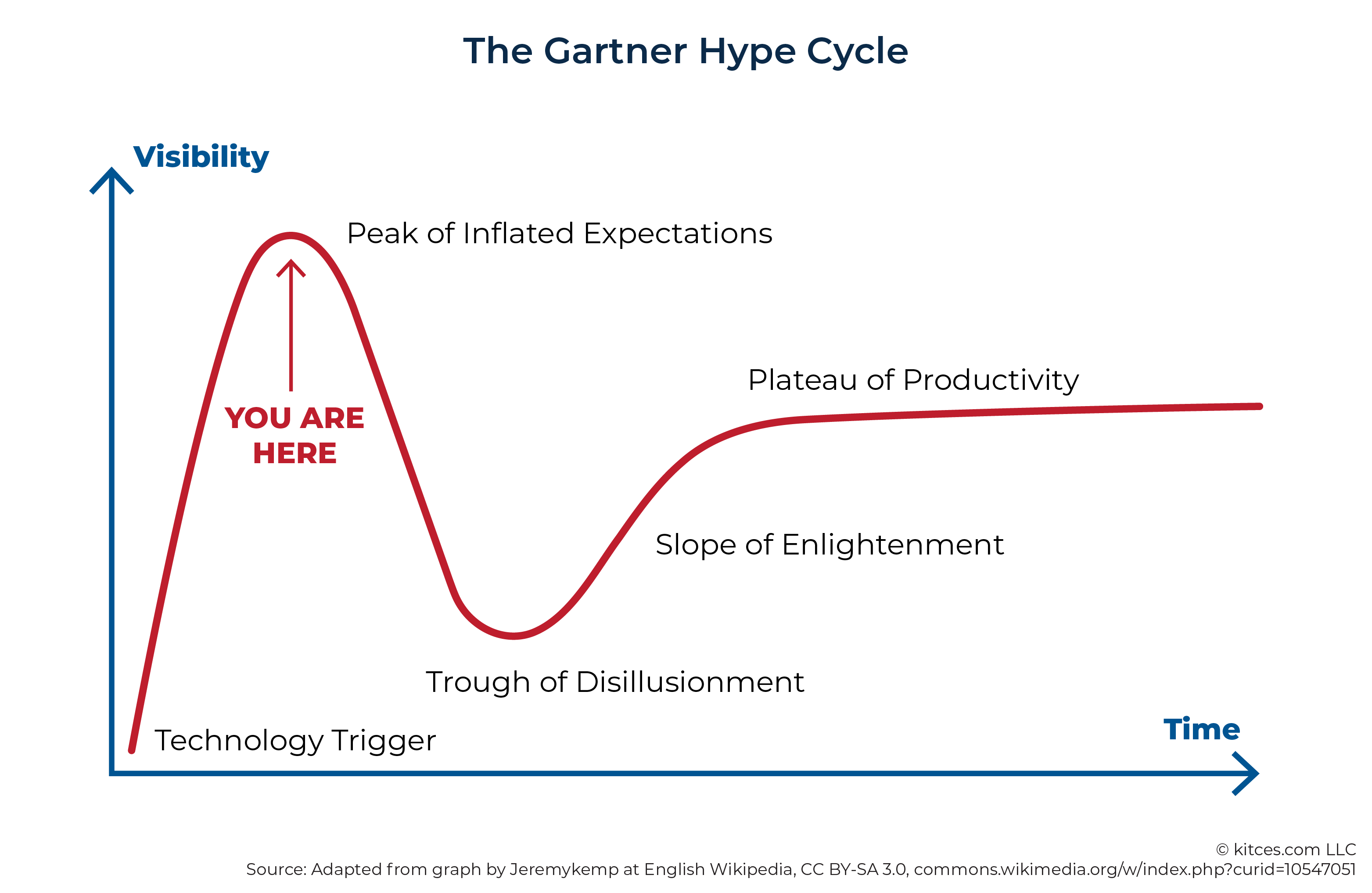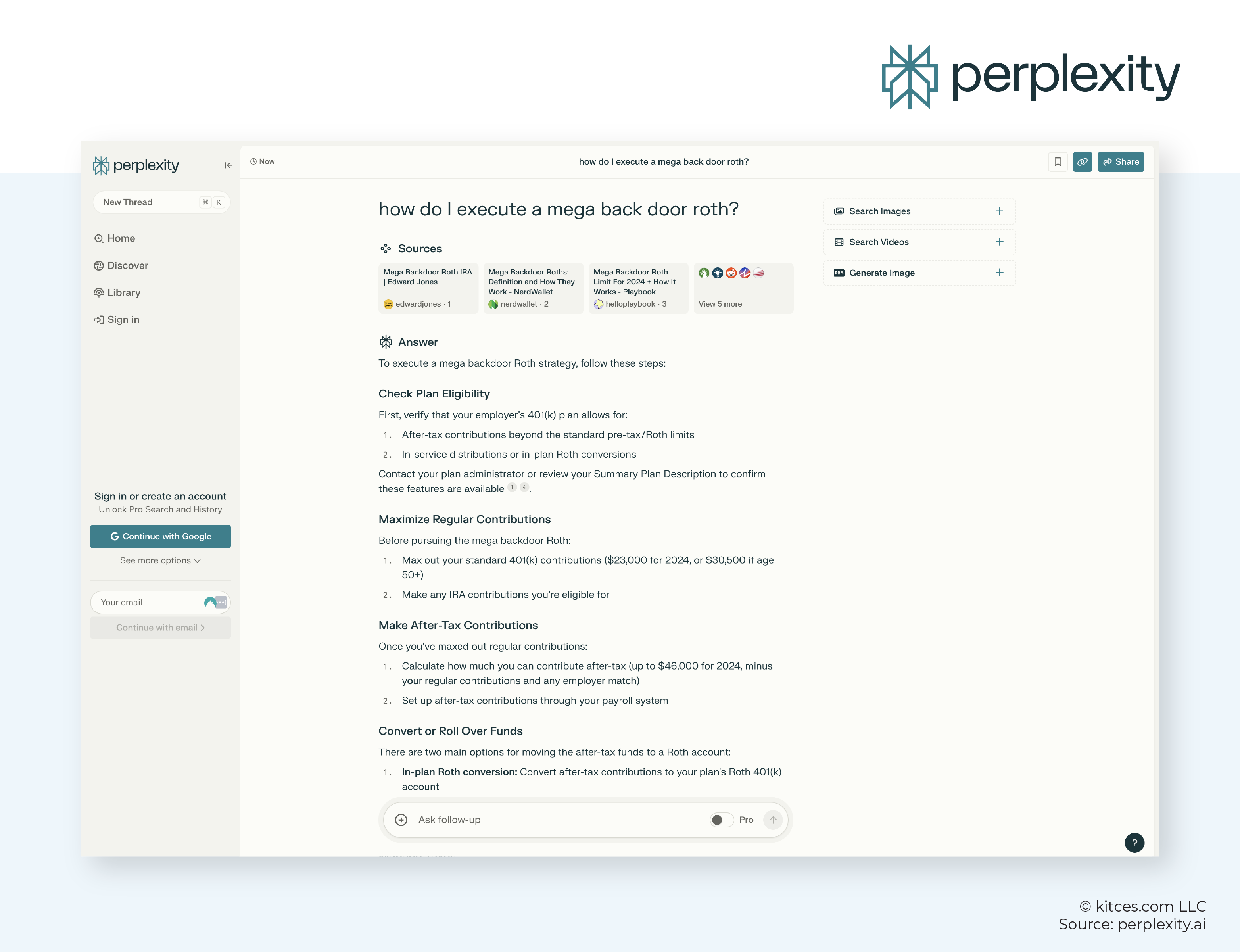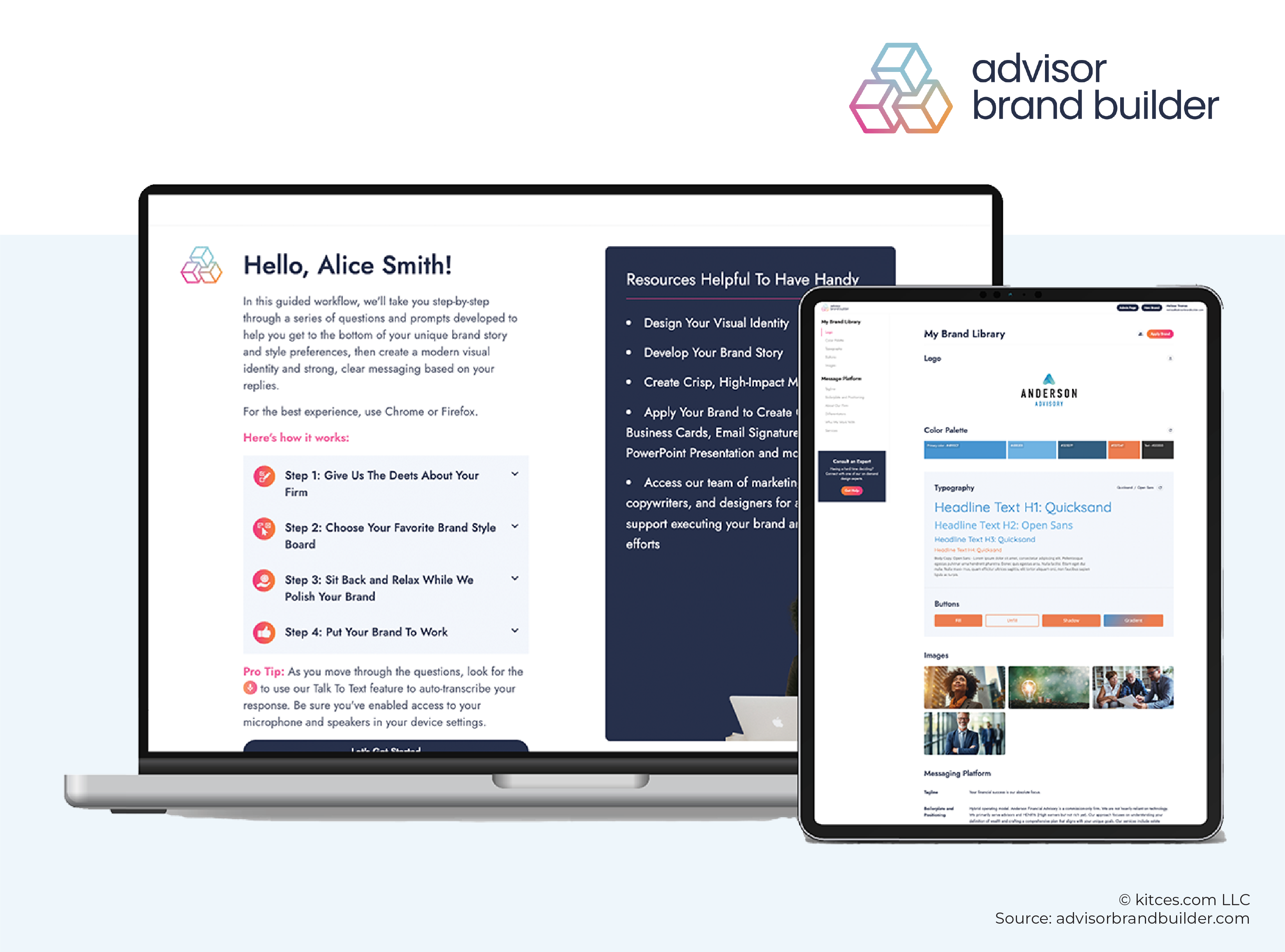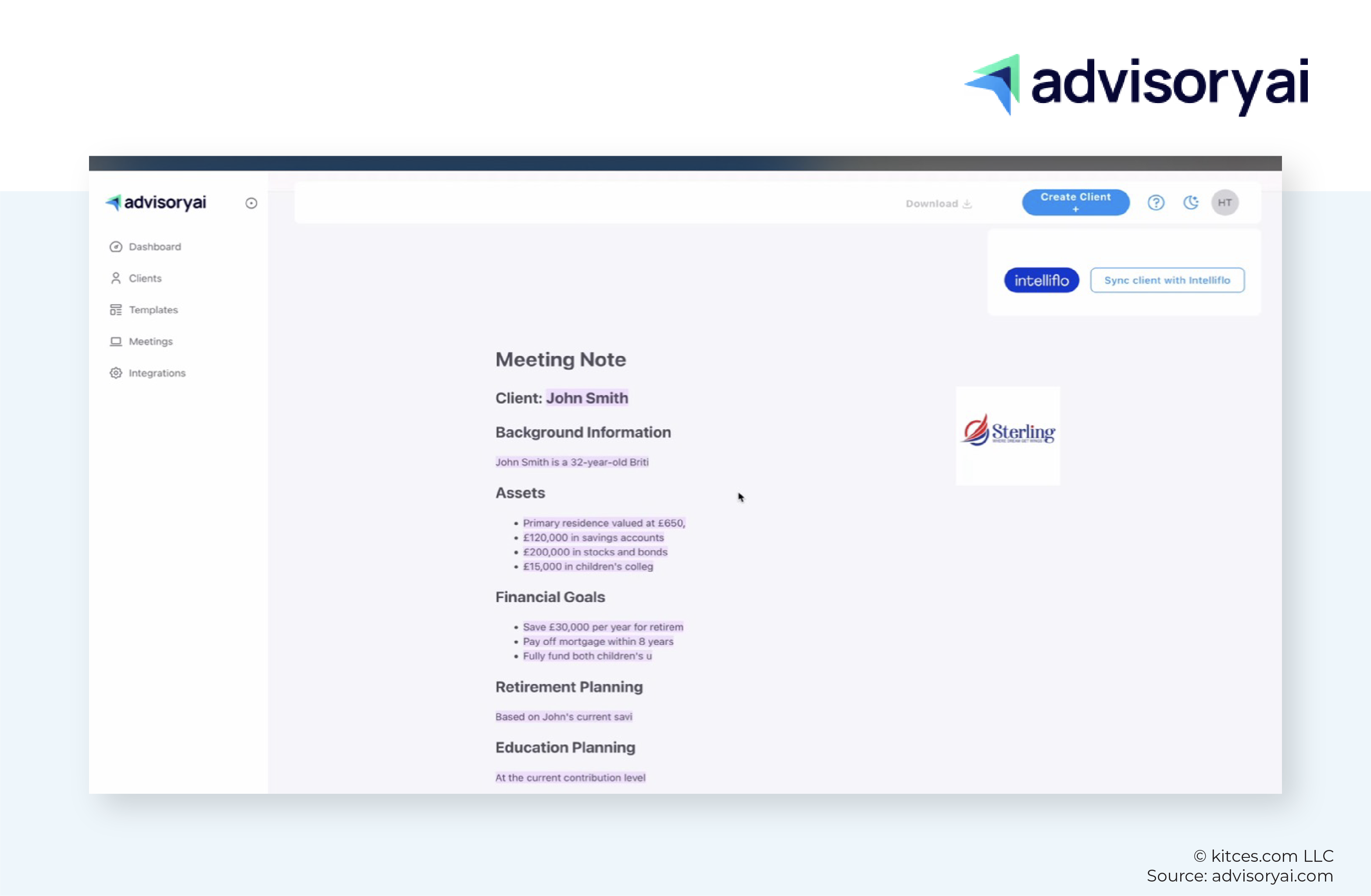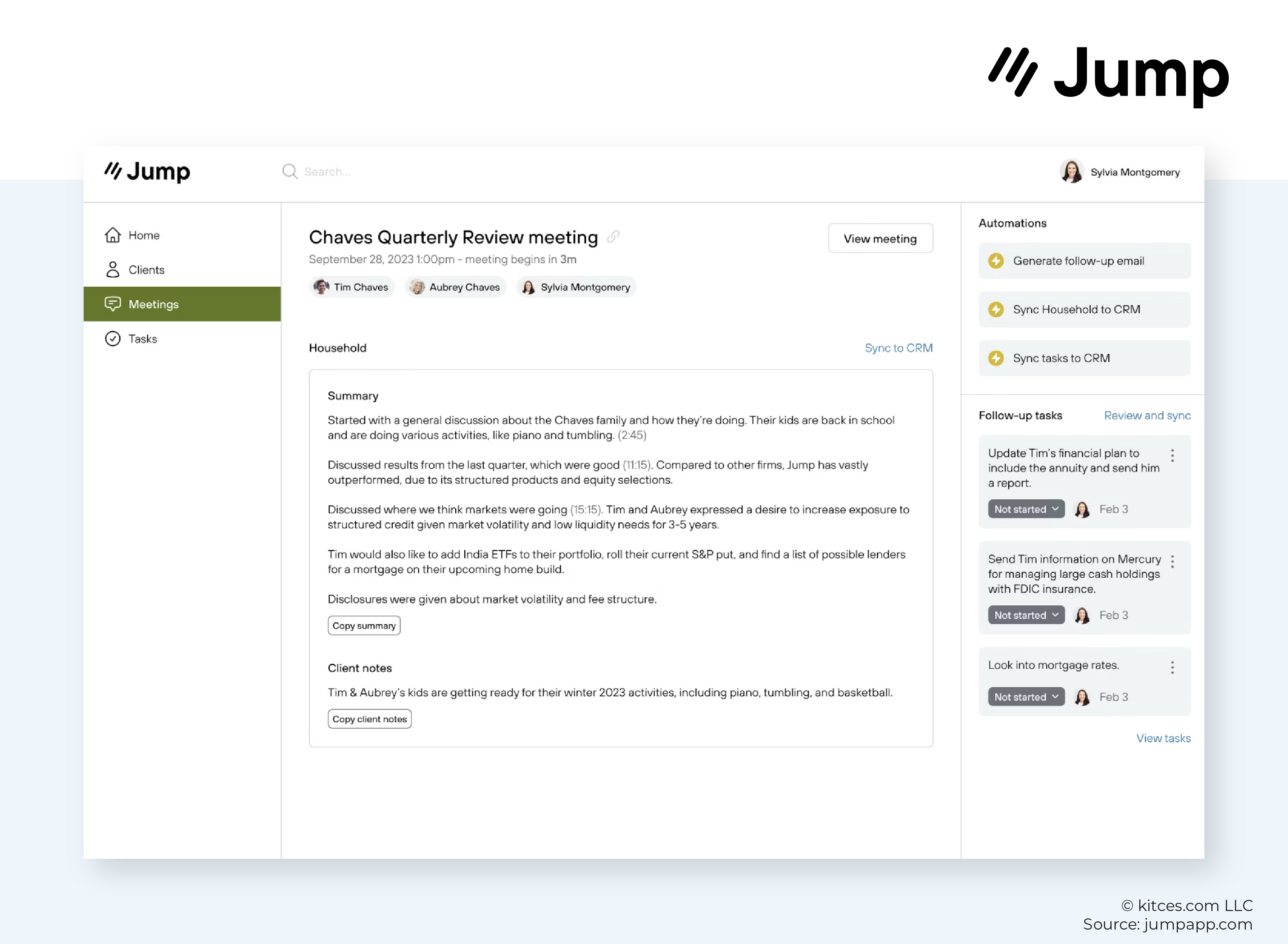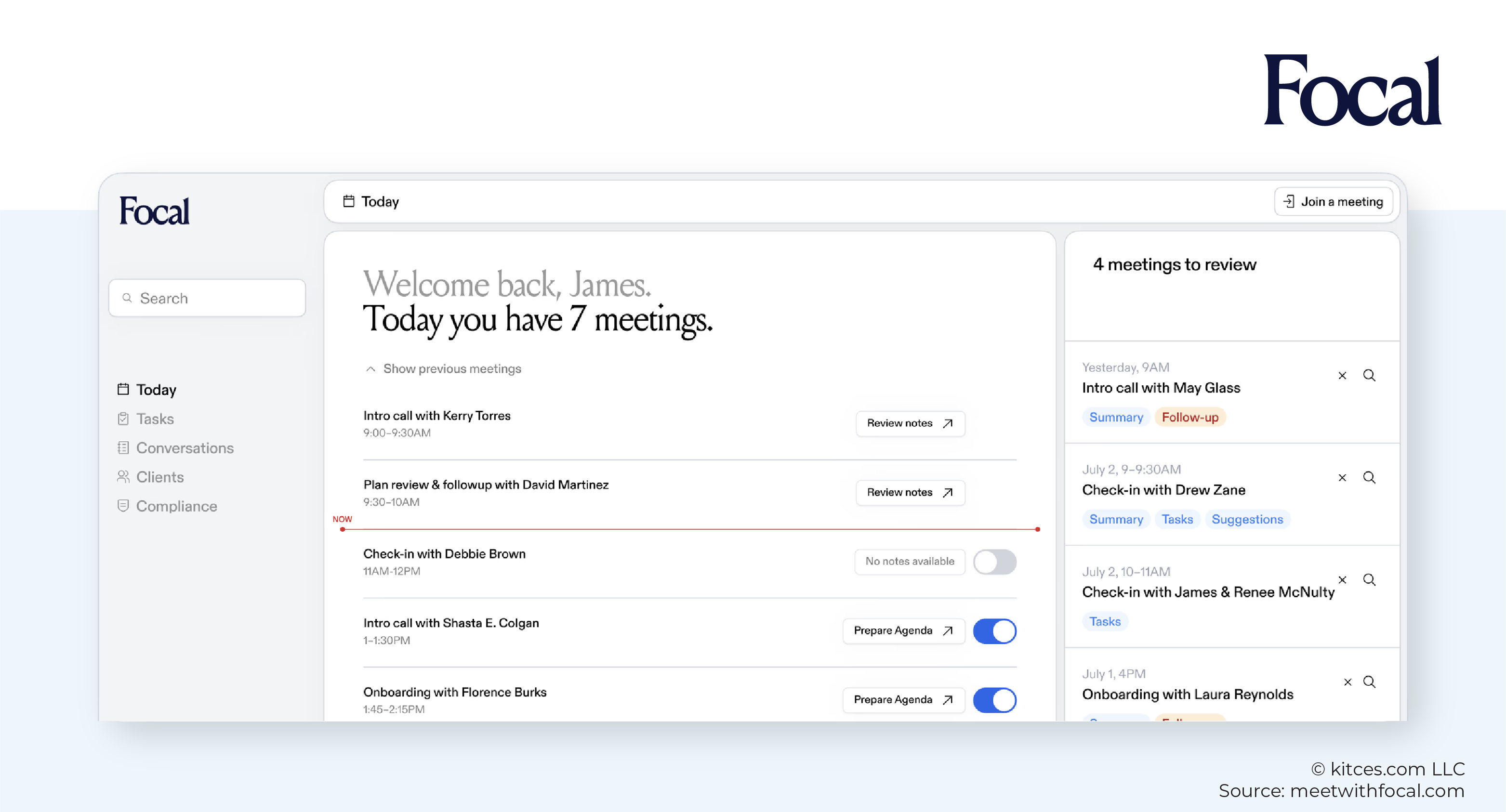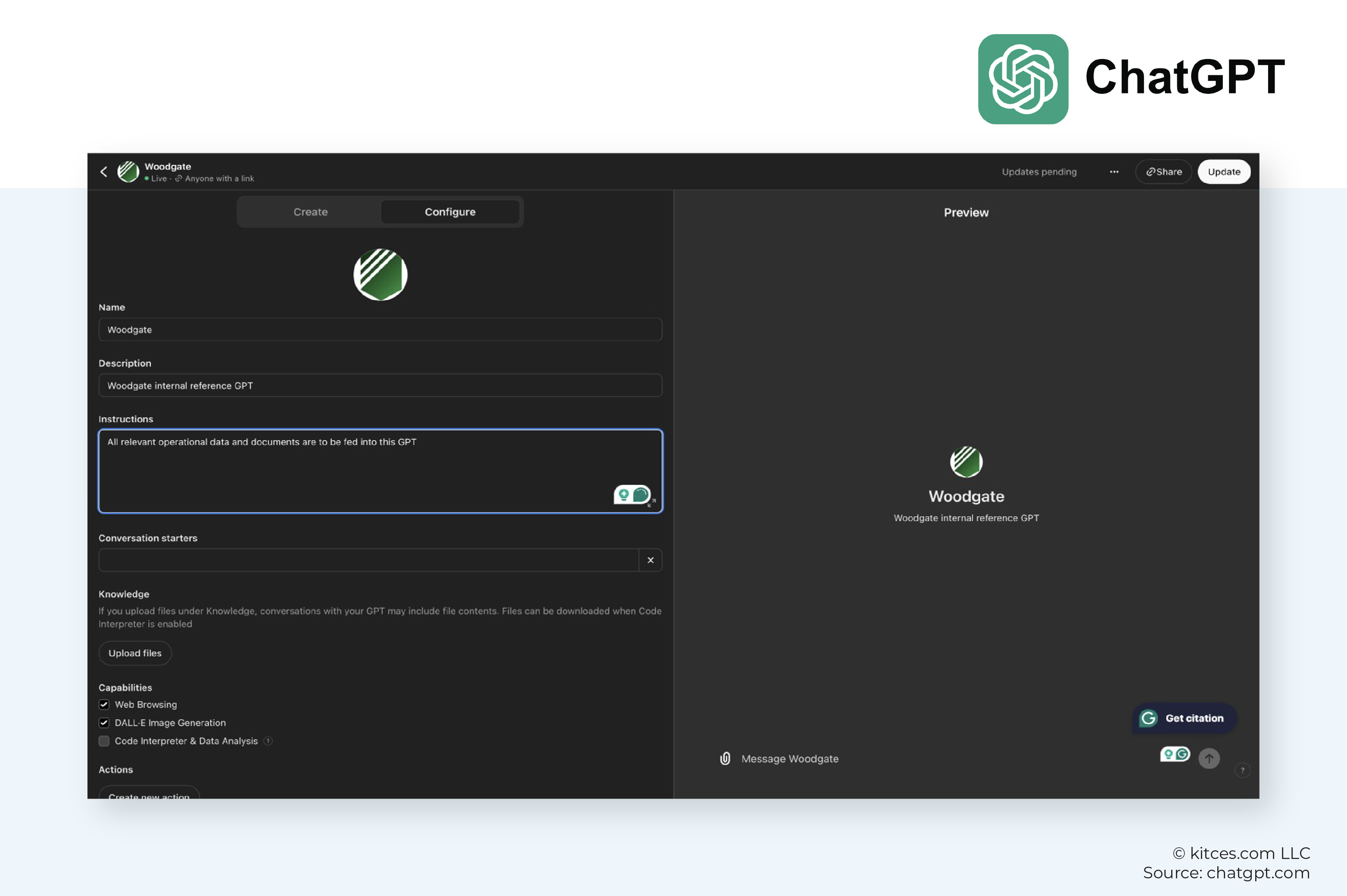Executive Summary
In the nearly 2 years since the launch of ChatGPT, there has been an explosion of new technology solutions incorporating Artificial Intelligence (AI). Today, AI is now almost ubiquitous across many of the tools that we use, from smartphone cameras to search engines to office productivity software. For financial advisors, too, a ballooning number of new advisor-focused AI tools has appeared over the last 24 months, purporting to save advisors' time and staffing needs by automatically performing previously manual tasks like creating meeting agendas, generating marketing materials, and even analyzing and recommending financial planning strategies.
And yet, despite the flood of new AI tools and the assurances that advisors hear from software providers and AI proponents that AI will soon prove to be life-changing in its ability to 'intelligently' perform any task that the user asks of it, the impact that AI will have in the long term is still unclear. Much like how other forms of technology in the past 30 years (such as online shopping in the early internet era and blockchain solutions in the late 2020s) went through early hype phases only to have the bubble burst when many of the business models based on the new technology proved to be unsustainable, AI is going through its own speculative phase where new AI solutions are popping up for nearly every use case imaginable – except, as the lessons from previous technology bubbles have shown, many of the use cases currently being offered for AI won't actually prove valuable enough to build successful solutions.
But the likelihood that many of today's AI solutions may fall flat in the short term doesn't necessarily mean that AI won't ultimately bring significant benefits for advisors; it just means those benefits may take a long time –possibly a decade or more – to become evident. At least to some extent, this will be the result of generative AI's ability to grow over time, as AI technology itself becomes more reliable and capable of a broader range of functions. Additionally, as it becomes clearer which AI use cases provide real value, those applications will gradually gain traction among advisors and may even become integral to how they serve clients and manage their businesses.
For the time being, however, it may be helpful for advisors to take a realistic approach to the value that AI tools will provide, especially in an environment where technology providers often make bold claims about their solutions' ability to save time and reduce costs. Some of the capabilities of today's AI tools (e.g., automating workflows or retrieving client information using a chatbot) may be useful to some extent, but if the processes that they replace don't take that much time to begin with, then the tools' benefits may not justify the additional cost to implement them. On the other hand, if the tool really does help advisors meaningfully cut the time they spend on inefficient tasks – such as client meeting preparation and follow-up – then they're more likely to be worth the cost outlay.
The key point is that, like any technology, AI itself isn't the solution to making advisors better and more successful; rather, it's a foundation on which solutions can be built to help advisors address specific challenges while maximizing the technology's current capabilities. For now, getting the most out of AI may mean focusing on more narrowly targeted AI solutions (rather than those offering a mosaic of tools, only some of which may hold real value) – as these are more likely to address the advisor's actual needs, instead of trying to be the "One Solution" for everything, regardless of whether the problem truly needs solving!
AI May Transform Advisory Practices In 10 Years… But In The Next 24 Months? Not So Much…
It's been less than 2 years since ChatGPT publicly launched in November 2022, and we are still in the early days of AI and its hype cycle, with countless people speculating how it will change and eliminate the need for assistants… and possibly even financial advisors. The reality is that much of this discussion fails to acknowledge that technological change doesn't happen overnight; it takes time. All too often, the new bright, shiny object (desktop computing, the internet, mobile computing, blockchain) is thrown at a problem with the assumption that doing so will fix the problem. It doesn't work that way, and as of now, it's pretty easy to conclude that there should be a "you are here" arrow drawn on the "Peak of Inflated Expectations" on the Gartner Hype Cycle.
New technology isn't the solution to change how we work; rather, it serves as a foundation to help us build those solutions. Using technology to fix a problem means first having a deep understanding of the practical problem itself, and then developing a solution that uses whatever tech tools are needed, including Generative AI (or "Gen AI" for short), to solve it.
What this means for advisors is that there will be a lot of noise they will have to tune out so that they can clearly see and understand whether or not the Gen AI solutions on the market they are being pitched today – and in days to come – actually help them solve the problems at hand.
Can they expect to find an AI tool that changes everything today and allows them to reduce their staff headcount by 50%? Quite simply, no. Can they expect that in 24 months? More than likely, that's also a no. But can it happen in 10 years…? That's a much more probable outcome, just as the rise of "robo" tools and various forms of automation have increased revenue/employee over the last 10 years.
As a Financial Planner and CFP professional in both Canada and the US, I have produced over 325 podcast episodes of the Fintech Impact Podcast, advised and consulted with multiple fintech/advisor tech companies, and have spoken internationally on the subjects of technology, digital transformation, and various other tech and practice management related topics. My experience and work with fintech companies has offered me valuable insights into the tech world and has inspired my own pursuit to leverage technology into my own practice and daily life.
Generative AI Isn't As Intelligent As It's Made Out To Be And Often Provides 'Solutions' Without Problems
Let's give credit where credit is due: Generative AI is the most meaningful technological change since the advent of mobile computing. However, as promising as it is, we need to be realistic about how it works and recognize what it does and doesn't do.
Generative AI is powered by large neural networks fed large amounts of data. The neural network is then 'trained' to find patterns within the data. Ultimately, Generative AI tools are enormous regression models looking for correlations. Whenever a user asks them for something, they return an answer composed of a vast amount of data with the highest probability of being right. But does it actually 'know' anything? No. Ask what comes after "1, 2, 3, 4". It won't answer 5 because it can count. Instead, it will scan its knowledge base to look for references to this question and, after receiving several million documents, sites, and other materials, determine that in 98.234761% of the scanned references to this question, the response was "5". Therefore, it believes (without even a shred of doubt) that the highest probability answer is 5. Meanwhile, a child could have used their fingers and demonstrated more understanding of what was being asked.
Note the term "highest probability". Anyone who has used various forms of Gen AI has experienced just how wrong AI answers can be, despite the answer's "highest probability of being right". Part of the issue lies in the limits of communication; when people are uncertain how to best prompt the system to get their desired response, they can ask AI ambiguous questions that can be easily misinterpreted.
Another part of it comes down to the AI system not connecting the dots properly and even 'hallucinating' about existing patterns in the data that don't exist. Given its inability to apply basic logic or actually 'know' anything, it doesn't have the ability to stop and say, "Wait a sec, that can't be right!" The good news is that, despite this, we can guide AI towards giving the correct actions/answers by feeding it multiple well-written prompts and confirming its accuracy (and challenging it when we find inaccurate information).
Currently, Gen AI is being framed as technology that will put us out of business or replace our staff, but so far, it's been primarily used to boost productivity and handle smaller tasks within our industry. While it can speed up tedious work, its propensity to be wrong means that it requires a different kind of work – reviewing its output to ensure accuracy. In doing so, at least for now, its efforts to expedite have also shifted the nature of the work, which is the norm with any new technological innovation.
I tend to get pitched many ideas in this space; the vast majority of those ideas have been poorly thought out with solutions to problems that don't actually exist. For example, some startups have proposed integrating AI tools with other systems via API to trigger workflows within systems that had no preexisting workflows or APIs to speak of. Others have suggested solutions for problems that weren't really problems, like creating a process that automates the creation of ad hoc reports that will compile the data however you like, but that requires more time to audit than simply generating the output from scratch.
The current reality is that we may be in the 'pets.com' era of Gen AI. When the dot-com bubble hit, people took old business models online and simply threw new tech at an old problem without necessarily thinking through how the business needed to change or even if consumers were ready for it. And as we know, most of those businesses failed and aren't around today. More recently, "Blockchain fixes that" was used to describe everything to the point that it was practically a meme. Yet, did those strategies actually work? While some of them might be working in the most well-thought-out use cases, for most cases and their respective altcoins, the answer is not so much.
Gen AI is doing amazing things and the various use cases for it are getting better fast. But it's still new, and its implementation and many of its early-use cases will miss the mark badly because AI is being used as a solution thrown at problems without understanding where the problems actually lie.
It isn't a revolutionary development to be able to type a request into your CRM to tell you which clients you haven't spoken with in over 6 months or who owns 'x' product, relying on the AI to answer those questions, when such reports could have easily been created with existing CRM reporting capabilities, without users needing to learn how to properly prompt the AI in order to get the right result. Neither is it revolutionary to streamline a process to complete an action in 1 button click that would have otherwise taken 3 button clicks. Yet, many pitches of how AI adds value amount to little more than this.
Tech Innovations Don't Improve Business Practices Overnight Because Humans Change Slowly
If the internet were a revolution, then cloud computing – that lets us move programs and data stored on our own computers to large server farms provided by Amazon, Microsoft, and Google – would be the catalyst that helped the internet grow up. While more companies than can be counted failed due to a lack of a legitimate use case or profitable business model when the dot-com bubble burst, in time, we got things that would have cost a fortune 20 years ago but that we now use daily for a price of near zero.
Technology finally caught up with the idea of storage anywhere, cloud-native software, and one-click shopping, and today, it has become much more affordable. Despite all the dot-com era predictions that the internet would be the end of brick-and-mortar retail businesses, 25 years later, they are still around. And even in the face of all their struggles, they are still making 5X the sales of online retailers!
Gen AI will have to do the same kind of growing up.
But there are real bottlenecks that will take time to get through. The biggest one is human beings themselves. People's habits are notoriously hard to change, especially when they involve a person who fears the loss of their job because the technology being implemented at their workplace is meant to displace them. When that happens, they can become Luddites throwing wrenches into the looms. But in the end, the future of our adoption will look a lot like the past, with technology augmenting the human experience and helping to redefine what work is.
Even if they are incentivized and not threatened, there is also a trust factor that must be earned slowly. How many people refused to input a credit card online for years for fear of fraud? I still had clients bragging about that circa 2010; meanwhile, the use of credit cards online hit critical mass in the early 2000s. While we may accept errors and imperfections in other people, we don't have the same tolerance for technology. Instead, we demand perfection. Look no further than the data on self-driving cars to see how this point becomes salient. While data is starting to point to self-driving cars being safer than human drivers in most cases, only 12% of Americans trust them. Technology being 'better' than humans isn't enough; it has to be much better than humans to overcome the implicit distrust we have of surrendering control to technology.
More often than not, full-scale adoption of technological advancements has been proven to require generational changes as younger people grow up experimenting with and adopting new technologies. To prove this, look no further than the current adoption rates for a near-ubiquitous form of AI we have had for over a decade: voice assistants like Siri, Alexa, and Google Assistant. As of late last year, adoption rates varied wildly between generations, with Millennials leading the way at 61% adoption, Gen X and Gen Z at around 50%, and Boomers at just over 30%. Although younger millennials never experienced smartphones without voice assistants, nearly everyone older needed to adapt their habits and embrace the new technology. Clearly, human willingness and desire to adopt new technology is largely inversely proportional to age.
While behavior and costs will change, let's remember many of the business models that failed after the dot-com bubble took years to recover and succeed later, not only because costs took time to come down, but also because people were slow to change.
I am confident that Gen AI's abilities will grow fast as a function of the compounding rate of change that comes from integrating tomorrow's tools with today's tools, but for the time being, we will see a lot of misfires. So, for the next little while, expect to see a lot of AI solutions fall flat and be realistic about what is of value and impactful today.
Gen AI Today: What's Here, What's Coming, And What To Look Forward To
Right now, all Gen AI products can be broken down into 2 broad categories: 1) AI overlaid onto existing systems and 2) AI-native approaches to problems.
Gen AI Overlays
The first category of Gen AI products includes Gen AI overlays. This involves an existing software program that adds AI as a feature to an already existing product without changing the product itself. The user logs in and uses the program like they did before, but with a Gen AI overlay, there is a new functionality that has been added. The user doesn't have to use it or change anything about how they use the software if they don't want to.
Within the overlay category, the solutions can be segmented further based on how they're used within the existing software: Educational and Functional Use overlays.
The primary function of the first type of Gen AI overlay, educational overlays, is to help users learn how to use the program features. Most large software programs have robust support databases, training manuals, videos, forums, and release notes for people to learn how to use and support the software. But let's face it: The problem is that the experience simply isn't great. Searching for what the user needs using simple search queries or going through knowledge base directories is time-consuming and leaves much to be desired. Instead, being able to describe the problem to a useful and responsive chatbot, tell it what's actually needed, and then having the chatbot serve up specific answers with resources addressing multiple issues simultaneously creates a much more positive experience for the user.
For example, when using financial planning software, one could click on the chatbot and ask, "How do I implement 'x' financial planning strategy?" The AI could then serve up not just the specific knowledge base article on how to do "x" but also other content like training webinar videos where best practices around "x" was discussed. It could even offer recent release notes around how doing "x" has recently changed in the software. This approach is far preferable to looking up information in databases and poring through cumbersome user manuals.
The second type of Gen AI overlay, the Functional Use overlay, navigates the software and executes commands for the user. This reduces the learning curve and cognitive burden of figuring out how to use complex software and allows amateurs to leverage aspects of a software tool they may not have known existed. For example, this can be seen in Microsoft Office and its implementation of Copilot. While most Microsoft users take advantage of only a small fraction of all Office functionality, Copilot is expanding their familiarity with the tools available to them, helping them navigate a broader range of capabilities (e.g., using previously unfamiliar formulas in Excel to work with data faster and in new ways). Adobe Photoshop is another example of a software program implementing a Gen AI overlay, where users can now edit a photo by simply circling the area they want to change and telling the software what they want to do. They can tweak, remove, add, and create new images without needing to understand how to use any of the dozens of sophisticated but complex editing tools available in the program.
Everyone on the Kitces Financial AdvisorTech Solutions Map is looking to make their software easier to use. The more complex the software, the more easy-to-use software features will be valued by both the company and the user. But there will be limits based on the risk of using Gen AI and getting it wrong. There will also be misfires where implementing Gen AI solutions will amount to a nothingburger. Being able to tell an AI tool in a CRM system to show every client with a birthday in July who the advisor hasn't talked to in 6 months, who holds X security, or who meets whatever Venn diagram of facts the advisor wants to see is something that can already be implemented in various CRMs with a few button clicks using existing search filters and queries. Given that this use case only takes a few minutes to complete with basic CRM functionality the first time and can be saved for future use, purpose-building AI for this task is a nice-to-have but not exactly a game changer.
That being said, the only way to understand the value of these solutions will be to experiment with them. The good news is the overlays are relatively cost-effective, generally costing between $10–$20 each month. While not free, they are affordable enough that playing around or adopting them even with their potentially more limited functionality may be worth it. They are also far cheaper than active AI tools that can cost between 5–10X as much.
Gen AI-Native Approaches
The second category of Gen AI products involves implementing new AI-native approaches to old problems. An AI-native approach doesn't just take existing software and add AI to it; instead, it creates new products that are designed with Gen AI at its core and that solve existing problems in new and novel ways compared to tools we had access to before.
While there are many new Gen AI-native products entering the market, we're still in the early days of Gen AI, which means that many of these tools are simple solutions to solve what many have already figured out it's good at doing. For example, instead of Googling things, answers to questions can be found using the likes of Perplexity, which doesn't just return links but also answers the question asked and offers references for the sources of the solutions it provides.
Other Gen-AI native tools are used in sites like Advisor Brand Builder, where advisors can build their own brand, including logos, colors, and content.
AdvisoryAI is another tool that only takes minutes (instead of hours!) to create reports and templates tying together information from multiple sources like CRMs, planning software, email, and other tools.
And instead of spending hours creating meeting agendas or summarizing meetings and follow-up notes, advisors can instead use programs like Zocks, Jump, or Focal to do much of the work with a few mouse clicks!
Advisors can even build their own knowledge base relatively easily using custom GPTs within ChatGPT by feeding their own information (PDFs, websites, etc.) into it and creating their own internal support bot.
The reality is that adoption of these tools is just the beginning, as they are the simplest and more obvious uses cases for Gen AI to date. A big shift in the industry is likely to follow when more complex software programs start implementing AI-native tools. The real question about Gen AI's potential will begin to emerge when companies start seeing how their competitors rely on more advanced AI capabilities.
We have already gotten a peek at this pre-Gen AI trend with Conquest starting to use AI to create financial plans. Unlike traditional financial planning software that requires the manual input of data or the selection of a single pre-defined strategy, Conquest provides an inventory of strategies to consider and optimizes each strategy for the client, providing the best application of that strategy and ranking all strategies based on their impact on the client. Want to optimize Social Security? Conquest tests every start date and identifies the best one for the client. What if the client has $1,000/month of free cash flow to save? Conquest shows what the optimal allocation between account types and spouses would look like. In addition, it identifies the strategies with the most significant impact, pointing advisors in the direction of the particular strategies that would be most beneficial for their clients.
Considering that all of this is just the beginning, imagine what a financial planning practice could look like when the transcription technology doesn't end with the action item but actually does the work both natively within the AI program being used and through integrations with other systems. For example, if a client mentioned they moved, the AI tool could prepare the required documentation for the client to sign and approve the request to update their address, send the documents to the client for e-signature, change the client's address in various systems, and notify third-party companies that need to know about the change… all while the meeting where the advisor first learns about the client's move is still in progress!
Or when a client emails their advisor with a simple question or request like a password reset, the advisor's AI agent not only can respond to the client's message but can also complete the task automatically, letting the advisor know that everything has been dealt with after the fact.
What will advisory firms look like when Gen AI moves beyond productivity with tools like Lydia, an educational AI platform being developed by the behavioral finance experts at Shaping Wealth that will train advisors on integrating behavioral finance into their practices and help them become more effective and self-aware planners by better understanding the people they serve?
How Advisors Can Move Forward And Find Ways To Leverage Gen AI
With the current opportunities for efficiency and promises of the future, where is an advisor to start?
My first piece of advice is to be curious and experiment. The only way for advisors to learn what's possible is for them to try things out for themselves. That said, advisors who aren't an early adopter type and are not interested in trying out 6 different systems to determine which is the best solution for a particular problem, this is the time for advisors to start talking to peers who are early adopters and see if they can help point in the direction of what solutions they have discovered that can have a positive impact for advisors today.
The second piece of advice is to accept that, similar to advisor tech stacks today, solutions will consist of a mosaic of different tools. There will be no one AI to rule them all anytime soon. It is far easier to get accurate AI results if users narrow the AI's attack vector with specific queries and prompts. Even AI has trouble when asked to be the jack of all trades and master of none. So, expect that using multiple AI tools will be the norm.
As for deciding what AI solutions to choose in the marketplace, the best AI products to spend time and money on are the ones that can replace or assist a process that fits the following criteria:
- Serves a core need, not just one that is nice to have;
- Involves repetitive tasks;
- Is time-consuming;
- Requires processes with minimal optionality (i.e., tasks don't require the user to review multiple options that may each involve assessing several possibilities); and
- Supports a straightforward process.
To demonstrate, let's consider how this framework applies to a previously mentioned AI solution: Meeting Notes.
- Serves a core need: Absolutely.
- Involves repetitive tasks: Check.
- Is time-consuming: Depends on how well an advisor takes notes, I don't think anyone would ever say "no" here.
- Requires processes with minimal optionality: For the most part, yes. While advisors can discuss anything and everything with a client, for the most part, we don't need to talk to them about an infinite list of topics. And what the AI needs to extract isn't that complex, either: Who took part, what was generally discussed, and what are the action items. This is something all of the general-purpose meeting-note takers like Zoom, Otter, or Fathom do well already. The industry-specific players like Focal, Jump, and Zocks have an advantage in that they better understand our language and will return text that reads "401(k)" instead of "four oh one kay".
- Supports a straightforward process: At its core, yes. Such a tool simply needs to report what was said, what needs to be done, and where it needs to be stored.
Like all other tech, AI tools should be implemented one at a time, being as gradual and methodical in your approach to continuously improve. Although we are currently a long way from accessing AI technology that can replace an assistant with a single tool that can take and carry out orders, the cumulative productivity gains to be garnered from the solutions that are on the market are meaningful. Will any of these take an advisor from a 40-hour to a 4-hour work week? No, at least not yet. But saving an hour a day is already a viable possibility, and more gains are on the way.
(And no, this article was not composed by AI, but feel free to use GPT Zero to confirm!)


